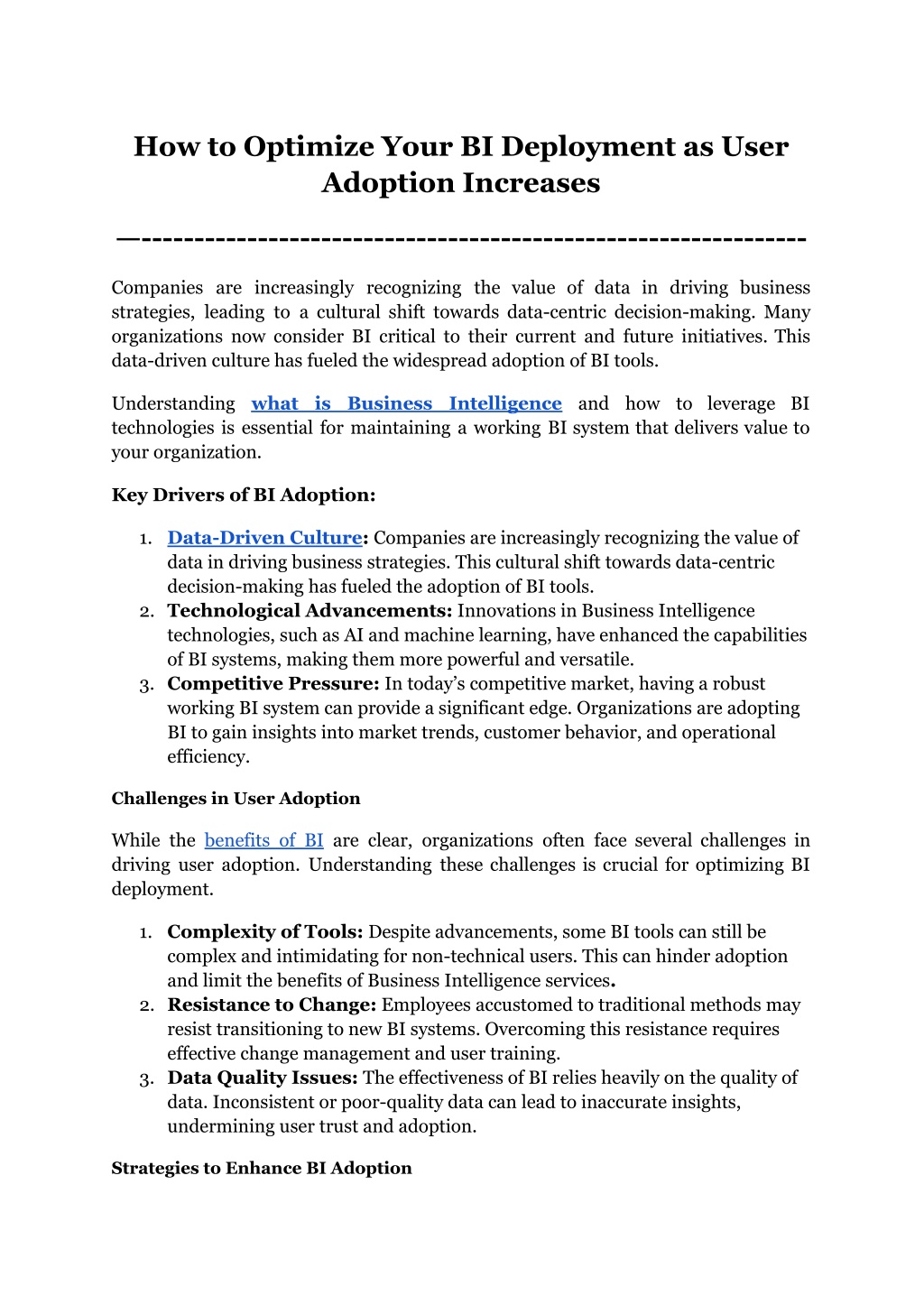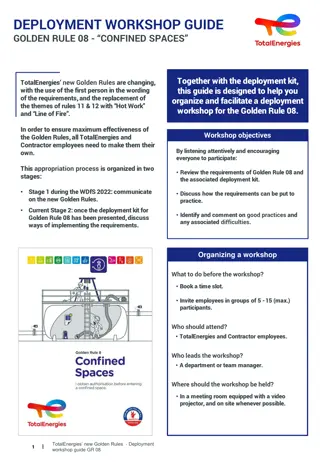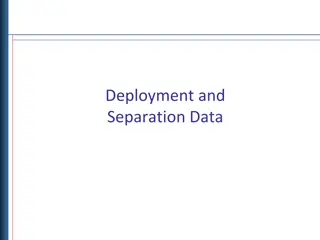
How to Optimize Your BI Deployment as User Adoption Increases
Understanding what is Business Intelligence and how to optimize it involves more than just implementing Business Intelligence technologies; it requires continuous evaluation and improvement. Business Intelligence services are most effective when they are tailored to the specific needs of the organization and its users.
Download Presentation

Please find below an Image/Link to download the presentation.
The content on the website is provided AS IS for your information and personal use only. It may not be sold, licensed, or shared on other websites without obtaining consent from the author. Download presentation by click this link. If you encounter any issues during the download, it is possible that the publisher has removed the file from their server.
E N D
Presentation Transcript
How to Optimize Your BI Deployment as User Adoption Increases --------------------------------------------------------------- Companies are increasingly recognizing the value of data in driving business strategies, leading to a cultural shift towards data-centric decision-making. Many organizations now consider BI critical to their current and future initiatives. This data-driven culture has fueled the widespread adoption of BI tools. Understanding what is Business Intelligence and how to leverage BI technologies is essential for maintaining a working BI system that delivers value to your organization. Key Drivers of BI Adoption: 1. Data-Driven Culture: Companies are increasingly recognizing the value of data in driving business strategies. This cultural shift towards data-centric decision-making has fueled the adoption of BI tools. 2. Technological Advancements: Innovations in Business Intelligence technologies, such as AI and machine learning, have enhanced the capabilities of BI systems, making them more powerful and versatile. 3. Competitive Pressure: In today s competitive market, having a robust working BI system can provide a significant edge. Organizations are adopting BI to gain insights into market trends, customer behavior, and operational efficiency. Challenges in User Adoption While the benefits of BI are clear, organizations often face several challenges in driving user adoption. Understanding these challenges is crucial for optimizing BI deployment. 1. Complexity of Tools: Despite advancements, some BI tools can still be complex and intimidating for non-technical users. This can hinder adoption and limit the benefits of Business Intelligence services. 2. Resistance to Change: Employees accustomed to traditional methods may resist transitioning to new BI systems. Overcoming this resistance requires effective change management and user training. 3. Data Quality Issues: The effectiveness of BI relies heavily on the quality of data. Inconsistent or poor-quality data can lead to inaccurate insights, undermining user trust and adoption. Strategies to Enhance BI Adoption
To maximize the benefits of BI, organizations need to implement strategies that address these challenges and promote widespread adoption. 1. User-Centric Design: Ensure that BI tools are designed with the end-user in mind. This involves creating intuitive interfaces, customizable dashboards, and easy-to-understand visualizations that cater to the needs of various user groups. 2. Comprehensive Training Programs: Investing in training and support is crucial. Offer tailored training sessions that address the specific needs of different user roles, from basic functionalities to advanced analytics. 3. Promoting a Data-Driven Culture: Foster a culture that values data-driven decision-making. Highlight success stories and demonstrate the tangible benefits of using BI to encourage adoption. 4. Regular Feedback and Improvement: Establish a feedback loop where users can share their experiences and challenges. Use this feedback to make continuous improvements to the BI system. Step 1: Assessing Your Current BI Deployment Effectively assessing your Business Intelligence (BI) deployment is crucial for ensuring it meets the needs of your organization and its users. This analysis will delve into the key performance metrics, the importance of user feedback, and the necessity of capacity analysis to identify and resolve potential bottlenecks. Performance Metrics: Evaluating Your BI System Evaluating the performance of your working BI system involves tracking several critical metrics that can provide insights into how well your deployment is functioning. Here are some key performance metrics to consider: 1. Query Performance: Measure the average response time for queries. Slow query performance can indicate underlying issues with data indexing or system configuration. 2. Data Refresh Rates: Assess how frequently your data is refreshed. For a working BI system, timely and accurate data is essential. Delays in data updates can lead to outdated insights and poor decision-making. 3. System Uptime: Monitor the system's uptime and availability. High availability is crucial for ensuring that users can access the BI tools whenever they need them, without interruptions. 4. User Adoption Rates: Track the number of active users and the frequency of their usage. High adoption rates indicate that your BI tools are effectively meeting the needs of the users. 5. Error Rates: Keep an eye on the frequency of system errors or failures. A high error rate can disrupt workflows and diminish user trust in the BI system. 2
By closely monitoring these metrics, you can identify areas that need improvement and ensure that your BI system continues to deliver value to the organization. User Feedback: Identifying Pain Points User feedback is an invaluable resource for understanding how well your BI deployment is meeting user needs. Here's how to effectively gather and analyze user feedback: 1. Surveys and Questionnaires: Conduct regular surveys to gather user opinions on various aspects of the BI system, such as usability, performance, and functionality. To get more information, ask specific questions. 2. Focus Groups: Organize focus groups with key users to discuss their experiences in depth. This can provide a more nuanced understanding of user satisfaction and areas for improvement. 3. Help Desk Data: Analyze data from help desk tickets to identify common issues and recurring pain points. This can help you prioritize areas that need immediate attention. 4. User Interviews: Conduct one-on-one interviews with users from different departments. This can uncover unique challenges faced by specific user groups and help tailor solutions to their needs. Analyzing this feedback allows you to address user concerns promptly, improve the overall user experience, and ensure that your BI deployment remains effective and relevant. Capacity Analysis: Identifying Bottlenecks Capacity analysis is essential for ensuring that your BI system can handle the growing demands of your organization. Here s how to conduct an effective capacity analysis: 1. Current Usage Patterns: Examine current usage patterns to understand peak usage times and the types of queries that consume the most resources. This can help you optimize resource allocation and improve performance. 2. Scalability Assessments: Evaluate the scalability of your current BI infrastructure. Determine whether it can easily scale to accommodate more users and larger datasets as your organization grows. 3. Hardware and Software Limitations: Identify any hardware or software limitations that could be affecting performance. This includes assessing server capacity, storage solutions, and network bandwidth. 4. Resource Allocation: Analyze how resources are currently allocated and identify any inefficiencies. Ensure that critical resources are prioritized for the most important tasks. 3
By conducting a thorough capacity analysis, you can identify potential bottlenecks and take proactive measures to address them. This ensures that your BI deployment remains robust and capable of supporting the organization's needs. Step 2: Scaling Infrastructure for Increased Demand As organizations increasingly rely on Business Intelligence (BI) to make data-driven decisions, scaling infrastructure to meet growing demands becomes crucial. This analysis explores the pros and cons of cloud-based vs. on-premises solutions, the importance of load balancing, and the optimization of data storage for speed and accessibility. Cloud vs. On-Premises: Pros and Cons Cloud-Based Solutions: Pros: Scalability: Cloud solutions provide almost limitless scalability, enabling you to easily adjust resources based on your needs. This adaptability is perfect for a working BI system that must handle varying demand levels. Cost-Effective: With a pay-as-you-go model, you only pay for the resources you use, which can be more economical than sustaining on-premises infrastructure. Accessibility: Cloud-based BI tools can be accessed from any location, making remote work and collaboration much more feasible. Automatic Updates: Cloud providers manage software updates and maintenance, ensuring your BI tools remain current with the latest features and security enhancements. 4
Cons: Data Security: While cloud providers implement robust security measures, some organizations have concerns about data privacy and control. Latency Issues: Depending on the provider and your internet connection, there may be latency issues that affect performance. Dependence on the Internet: Cloud-based solutions rely on Internet connectivity, which can be a limitation in areas with poor Internet infrastructure. On-Premises Solutions: Pros: Data Control: On-premises solutions give you complete control over your data, which is crucial for organizations with strict data security and compliance requirements. Customization: You can customize your infrastructure and BI tools to meet specific organizational needs. Latency: With data stored locally, on-premises solutions often have lower latency, providing faster access to information. Cons: Scalability: Scaling on-premises infrastructure requires significant investment in hardware and IT resources, which can be time-consuming and costly. Cost: Maintaining on-premises infrastructure involves ongoing costs for hardware, software, and personnel. Accessibility: Remote access can be more challenging to set up and manage compared to cloud solutions. Choosing between cloud and on-premises solutions depends on your organization's specific needs, including scalability requirements, budget, and data security considerations. Load Balancing: Efficient Traffic Distribution Implementing load balancing is essential for ensuring that your BI system can handle increased demand without compromising performance. Load balancing distributes network traffic across multiple servers, preventing any single server from becoming a bottleneck. Some key benefits of Load Balancing: Improved Performance: By distributing traffic evenly, load balancing ensures that no single server is overwhelmed, leading to faster response times and a smoother user experience. 5
Increased Reliability: Load balancers can detect server failures and automatically reroute traffic to healthy servers, minimizing downtime and ensuring continuous availability. Scalability: Load balancers make it easier to add or remove servers as demand fluctuates, providing the flexibility needed for a working BI system. Enhanced Security: Some load balancers offer security features such as SSL offloading, which can protect your BI infrastructure from cyber threats. To effectively implement load balancing, consider using advanced load balancers that can handle various types of traffic and provide detailed performance metrics. This will help you optimize your BI deployment and ensure it can scale seamlessly as user demand increases. Data Storage Solutions: Speed and Accessibility Optimizing data storage is crucial for maintaining the speed and accessibility of your BI system. Here are some strategies to consider: 1. Hybrid Storage Solutions: Combining on-premises and cloud storage can provide the best of both worlds. Critical data can be stored locally for fast access, while less frequently accessed data can be stored in the cloud to reduce costs. 2. In-Memory Storage: Using in-memory storage solutions can significantly improve query performance by reducing the time needed to access data from disk. This is particularly beneficial for real-time analytics and high-performance BI applications. 3. Data Partitioning: Partitioning your data can help improve query performance and manage large datasets more efficiently. By dividing data into smaller, more manageable pieces, you can reduce the time it takes to retrieve and analyze information. 4. Data Compression: Implementing data compression techniques can reduce storage requirements and improve performance. Compressed data takes up less space, which can speed up data retrieval and processing times. By optimizing your data storage solutions, you can ensure that your BI system remains fast and accessible, even as the volume of data and the number of users grow. Step 3: Enhancing User Experience and Performance in BI Ensuring a positive user experience and optimal performance in your Business Intelligence (BI) deployment is essential for maximizing its effectiveness and user satisfaction. User Training and Support: Building Proficiency 6
One of the key aspects of enhancing the user experience is providing robust training and support. Effective training programs not only improve user proficiency but also boost adoption rates and satisfaction. 1. Comprehensive Training Programs: Role-Based Training: Tailor training sessions to the specific needs of different user roles within the organization. For instance, data analysts may require in-depth training on advanced analytics features, while business users might need a focus on interpreting dashboards and reports. Interactive Workshops: Conduct hands-on workshops that allow users to practice using the BI tools in real-world scenarios. This helps build confidence and ensures that users are comfortable with the system. Online Resources: Develop a library of online resources, including video tutorials, step-by-step guides, and FAQs. These resources provide users with on-demand support and can be especially helpful for new users or those needing a refresher. 2. Ongoing Support: Help Desk and Support Teams: Establish a dedicated help desk or support team to assist users with any issues or questions. Quick and effective support can prevent frustration and maintain user engagement. User Communities: Foster a community where users can share tips, ask questions, and collaborate. This peer support can enhance learning and problem-solving. By investing in comprehensive training and support, you can ensure that users are proficient with your BI tools, leading to higher satisfaction and more effective use of Business Intelligence services. Interface Customization: Meeting Diverse Needs Customizing dashboards and reports to meet the diverse needs of your users is crucial for enhancing their experience and ensuring that they can easily access the information they need. 1. User-Centric Design: Personalized Dashboards: Allow users to create and customize their own dashboards based on their specific needs and preferences. This ensures that they have quick access to the most relevant data and insights. Role-Based Views: Develop different dashboard views for various roles within the organization. For example, executives might need high-level summaries, while analysts require detailed data views. 7
2. Interactive Visualizations: Drag-and-Drop Functionality: Implement drag-and-drop features that allow users to easily manipulate data and create custom reports. This empowers users to explore data without needing extensive technical knowledge. Real-Time Updates: Ensure that dashboards and reports are updated in real-time, providing users with the most current information. This is essential for a working BI system that supports timely decision-making. 3. Accessibility: Mobile Access: Ensure that BI tools are accessible on mobile devices, allowing users to access data and insights on the go. This flexibility is particularly important for executives and sales teams who are frequently on the move. User-Friendly Interfaces: Design interfaces that are intuitive and easy to navigate. Simplified interfaces reduce the learning curve and make it easier for users to find the information they need. By focusing on interface customization, you can create a more user-friendly BI environment that caters to the diverse needs of your organization, enhancing the overall user experience with Business Intelligence technologies. Performance Tuning: Optimizing Queries and Load Times Performance tuning is essential for ensuring that your BI system operates efficiently and delivers fast, accurate insights. This involves optimizing queries and reducing load times to maintain a smooth user experience. 1. Query Optimization: Indexing: Use indexing to speed up query performance. Proper indexing can significantly reduce the time it takes to retrieve data, enhancing the responsiveness of your BI system. Query Simplification: Simplify complex queries by breaking them into smaller, more manageable parts. This not only improves performance but also makes it easier to identify and troubleshoot issues. 2. Data Caching: In-Memory Processing: Implement in-memory processing to cache frequently accessed data. This reduces the need to repeatedly retrieve data from disk, speeding up query responses and improving overall performance. Result Caching: Cache the results of common queries to reduce processing time for subsequent requests. This is particularly useful for dashboards that are accessed frequently. 3. System Optimization: 8
Load Balancing: Spread the data out evenly among the servers so that no one server becomes a bottleneck. This ensures that your BI system can handle increased demand without compromising performance. Resource Allocation: Allocate resources effectively to ensure that critical tasks receive priority. This includes managing CPU, memory, and storage to optimize system performance. By implementing these performance-tuning techniques, you can ensure that your working BI system remains fast and responsive, providing users with the quick insights they need to make informed decisions. Step 4: Ensuring Data Security and Compliance in BI Protecting sensitive data and adhering to regulatory standards are critical for maintaining trust and ensuring the longevity of your BI deployment. Security Protocols Implementing robust security protocols is the first step in safeguarding your BI environment. Here are key strategies to enhance data security: 1. Encryption: Data at Rest: Encrypting data stored in databases and data warehouses ensures that even if physical security is breached, the data remains protected. This is crucial for maintaining the integrity of your Business Intelligence technologies. Data in Transit: Encrypting data as it moves between servers and endpoints prevents unauthorized access during transmission. This includes using protocols like TLS (Transport Layer Security) for secure communication. 2. Firewalls and Intrusion Detection Systems (IDS): Firewalls: Implement firewalls to create a barrier between your internal network and potential external threats. Firewalls can filter incoming and outgoing traffic based on predetermined security rules. IDS: Use intrusion detection systems to monitor network traffic for suspicious activity. IDS can alert you to potential breaches, allowing for swift action to mitigate threats. 3. Regular Security Audits: Vulnerability Assessments: Conduct regular vulnerability assessments to identify and address potential security weaknesses. This proactive approach helps ensure that your BI environment remains secure against evolving threats. Penetration Testing: Engage in penetration testing to simulate cyber-attacks and evaluate the effectiveness of your security measures. 9
This helps identify and rectify vulnerabilities before they can be exploited. Implementing these security protocols can protect sensitive data and ensure users' continued trust in your working BI system. Compliance Standards Ensuring compliance with relevant data protection regulations is essential for avoiding legal penalties and maintaining user trust. Here are key considerations for compliance: 1. Understanding Regulations: GDPR: For organizations operating in Europe or handling European citizens' data, compliance with the General Data Protection Regulation (GDPR) is mandatory. This includes ensuring data privacy, obtaining explicit consent for data collection, and allowing users to exercise their data rights. CCPA: The California Consumer Privacy Act (CCPA) imposes similar requirements for businesses handling the personal data of California residents. Understanding and complying with CCPA is crucial for avoiding legal issues in the US. HIPAA: For organizations in the healthcare sector, compliance with the Health Insurance Portability and Accountability Act (HIPAA) is necessary to protect patient data and ensure privacy. 2. Data Governance Policies: Data Classification: Implement data classification policies to categorize data based on its sensitivity and importance. This helps in applying appropriate security measures and ensuring compliance with relevant regulations. Data Retention and Disposal: Establish clear policies for data retention and disposal. Retaining data only as long as necessary and securely disposing of it when no longer needed helps in minimizing risks and maintaining compliance. 3. Regular Compliance Audits: Internal Audits: Conduct regular internal audits to ensure that your BI deployment adheres to all applicable regulations. This proactive approach helps in identifying and addressing compliance issues before they escalate. Third-Party Audits: Engage third-party auditors to validate your compliance efforts. Independent audits provide an objective assessment of your compliance status and highlight areas for improvement. 10
By understanding and adhering to relevant compliance standards, you can ensure that your Business Intelligence services operate within legal boundaries and maintain user trust. User Access Control: Managing Permissions Effectively Effective user access control is critical for protecting sensitive data and ensuring that only authorized users can access specific information. Here are strategies for managing user permissions: 1. Role-Based Access Control (RBAC): Defining Roles: Clearly define user roles based on job functions and responsibilities. For instance, data analysts might need access to detailed datasets, while business users require access to summary reports. Assigning Permissions: Assign permissions based on user roles. This minimizes the risk of unauthorized access and ensures that users only have access to the data necessary for their tasks. 2. Least Privilege Principle: Minimizing Access: Grant users the minimum level of access required to perform their duties. This reduces the risk of data breaches and limits the potential damage if an account is compromised. Regular Reviews: Conduct regular reviews of user access levels to ensure that permissions remain appropriate as job roles and responsibilities change. 3. Multi-Factor Authentication (MFA): Enhancing Security: Implement multi-factor authentication to add an extra layer of security. MFA requires users to provide multiple forms of verification before gaining access, reducing the risk of unauthorized entry. 4. Activity Monitoring: Tracking Access: Monitor user activity to detect any unusual or unauthorized access attempts. Logging and reviewing access attempts can help identify potential security breaches and take timely corrective actions. By implementing effective user access control measures, you can protect sensitive data, ensure compliance, and maintain the integrity of your BI system. Step 5: Using Advanced Analytics and Automation in BI Advanced analytics encompasses a variety of techniques and technologies that go beyond traditional data analysis. These include predictive analytics, machine learning, and artificial intelligence (AI). By integrating these advanced capabilities, organizations can uncover deeper insights and make more accurate predictions. 11
In finance, predictive analytics can assess credit risk, detect fraud, and optimize investment strategies. By detecting potential risks early, organizations can implement proactive strategies to mitigate them. Marketing teams can leverage machine learning to segment customers based on behavior, preferences, and demographics. This enables more targeted marketing campaigns and improves customer engagement. The Role of Automation in BI Automation in BI involves using technology to perform tasks that traditionally require human intervention. This can significantly improve efficiency, accuracy, and consistency. 1. Data Integration and ETL (Extract, Transform, Load): Automated Data Integration: Automation tools can streamline the process of integrating data from various sources into your BI system. This ensures that data is consistently up-to-date and accurate, providing a solid foundation for analysis. ETL Processes: Automating ETL processes reduces the time and effort required to prepare data for analysis. This includes extracting data from different sources, transforming it into a suitable format, and loading it into a data warehouse or BI platform. 2. Report Generation: Scheduled Reports: Automation allows for the scheduling of regular reports, ensuring that stakeholders receive timely insights without manual intervention. This is particularly useful for recurring reports, such as weekly sales summaries or monthly performance reviews. Ad-Hoc Reporting: Users can generate ad-hoc reports on demand, without needing to rely on IT or data teams. This empowers business users to access the information they need quickly and independently. 3. Alerting and Notifications: Real-Time Alerts: Automated alerts can notify users of critical events or anomalies in real-time. For example, a sudden drop in sales or an unexpected spike in website traffic can trigger an alert, enabling immediate investigation and response. Threshold-Based Notifications: Set thresholds for key metrics, and receive notifications when these thresholds are crossed. This helps in proactive management and quick decision-making. 4. Workflow Automation: Task Automation: Automate routine tasks, such as data validation, cleansing, and formatting. This not only saves time but also reduces the risk of human error. 12
Approval Processes: Implement automated approval workflows for processes like budget approvals or project proposals. This ensures that tasks move through the system efficiently and consistently. By leveraging automation, you can enhance the efficiency and effectiveness of your Business Intelligence services. Automation frees up valuable time for your analysts, allowing them to focus on more complex and strategic tasks. Integrating Advanced Analytics and Automation To fully leverage the benefits of advanced analytics and automation, it s essential to integrate these capabilities seamlessly into your BI deployment. 1. Choosing the Right Tools: BI Platforms: Select BI platforms that support advanced analytics and automation. Look for features like machine learning integration, automated data workflows, and customizable reporting. Third-Party Tools: Consider integrating third-party tools that specialize in specific advanced analytics or automation tasks. Ensure that these tools can easily integrate with your existing BI infrastructure. 2. Training and Support: User Training: Provide comprehensive training for users to help them understand and utilize advanced analytics and automation tools effectively. This includes both technical training for data analysts and business-focused training for end-users. Ongoing Support: Establish a support system to assist users with any issues or questions they may have. This ensures that they can leverage these tools to their full potential. 3. Continuous Improvement: Feedback Loop: Establish a feedback loop to gather input from users on their experiences with advanced analytics and automation tools. Use this feedback to continuously improve and optimize your BI deployment. Regular Updates: Stay up-to-date with the latest advancements in Business Intelligence technologies. Regularly update your BI system to incorporate new features and capabilities. Conclusion As user adoption of your BI deployment increases, optimizing your infrastructure becomes essential for maintaining performance, ensuring user satisfaction, and driving better business outcomes. By focusing on key strategies such as continuous monitoring, regular updates, and leveraging user feedback, you can create a robust, efficient, and user-friendly BI environment. 13
Grow offers a powerful platform that supports these optimization efforts. With its advanced features and user-centric design, Grow helps organizations seamlessly scale their BI deployments to meet growing demand. Whether you're integrating advanced analytics or automating routine tasks, Grow's intuitive interface and comprehensive support ensure your working BI system remains a valuable asset. Ready to take your BI deployment to the next level? Try Grow with a 14-day free trial and experience firsthand how it can enhance your Business Intelligence strategies. Additionally, check out the latest Grow.com Reviews & Ratings 2024 on TrustRadius to see how other businesses have benefited from this powerful BI tool. By adopting these best practices and leveraging the capabilities of Grow, you can ensure your BI deployment is optimized for increased user adoption, driving continued success and insights for your organization. 14






















